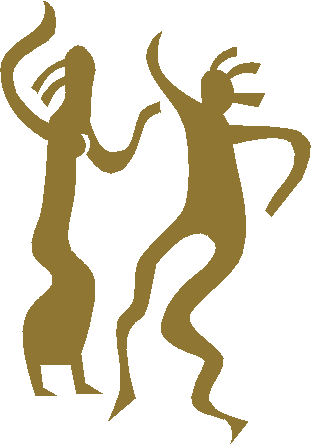| LEADING
TECHNIQUES  All leads emanate from the body, thus you hear of
teachers referring to body leads. Even if the only physical connection between you and
your partner is through the hands, the source of the lead is still the body. To be
more precise, the source is the solar plexus, or the diaphragm, that small round muscle at
the bottom of the ribs. In dancing, this is known as the Center
Point of Balance or CPB. The chest, arms, hand and fingers, are mere extensions of the
body, through which the lead is coursed. Because of this, the partners should always
maintain a clear and sensitive connection with each other, so that each lead can easily be
read by the follower, and the follower can react on the intended time with the intended
step and position in the intended direction. All leads emanate from the body, thus you hear of
teachers referring to body leads. Even if the only physical connection between you and
your partner is through the hands, the source of the lead is still the body. To be
more precise, the source is the solar plexus, or the diaphragm, that small round muscle at
the bottom of the ribs. In dancing, this is known as the Center
Point of Balance or CPB. The chest, arms, hand and fingers, are mere extensions of the
body, through which the lead is coursed. Because of this, the partners should always
maintain a clear and sensitive connection with each other, so that each lead can easily be
read by the follower, and the follower can react on the intended time with the intended
step and position in the intended direction.
The CHEST LEAD
In
Closed Position, the man indicates that he is moving forward by giving a chest lead to his
partner. The man’s upper body moves forward; the lady at once senses his direction
and steps backward. If he intends to move forward rapidly with a series of quick steps as
in Foxtrot, his right hand should relax its grip behind her back. If his intended movement
forward is slow, his right hand should hold her rather firmly, restraining her movement.
Another cue that indicates a man’s forward step is for him to raise his right elbow
slightly.
The
SHOULDER AND ARM LEAD
When
stepping into a turning step, the man indicates a turn to his left by bringing his right
shoulder forward and raising his right elbow. Similarly, if he is going to turn right, his
left shoulder comes forward, indicating the direction of the turn.
When
leading his partner into a turning step, he signals by raising her held hand by first
slightly moving it to the side and then up in a smooth curve. This not only prevents them
from straining their shoulder but also gives the lady enough time to process the signal.
His fingers then turn her fingers in the direction of the turn. Avoid lifting the hand
straight up to make a lady turn. This could cause a strain on the shoulder. Instead make a
narrow smooth semi-circle to the side and then up.
When
leading his partner into a semi-closed or open position, he drops his right elbow; and the
heel of his right hand helps to turn the lady into the intended direction and position.
The HAND
AND FINGER LEADS
Many
specific hand leads help indicate changes in direction or position. The palm of the
man’s hand, pressed against the lady’s back, brings her toward him. Pressed
against the left side of her waist, the hand may guide her into a side step to her
right.
To make
her face left to a Right Parallel Position, a gentle but definite pressure of the fingers
of his right hand beneath her shoulder blade will direct her to face left. His left hand
is not as useful in leading in Closed Position, but may serve to reinforce other
leads.
In
Two-Hand or One-Hand Position, her four fingers should rest firmly but lightly on his four
fingers in perpendicular position. They both touch and rest their thumbs lightly on the
back of their partner’s hands. This hand hold gives assurance for the lady that the
man will not let her go, and provides enough flexibility to maneuver their hands and
fingers as they move and change directions.
As the
man raises her right hand to the side and up to signal a turn to the right, he adjusts his
hand to freely move with hers. It could end up on top of her hand at the completion of the
turn, but he can adjust his hand to put it back into a position under hers. That is why
it's important to hold each other slightly and not grip hands.
Using his left hand
to make her turn left, he moves her right hand slightly inside then up, he should twist
fingers inside her hand so that they switch positions, and proceeds to lead her turn to
the left. He opens his fingers to sandwich her fingers between any two of them
(switching fingers as necessary) during the whole turn. This requires some versatility in
the man's fingers but makes the amateur lady dancer feel secure even in multiple turns.
In multiple turns,
only their fingers should be touching to provide maximum maneuverability without letting
go. Keep hands above the head, and send the finger signal right before the previous turn
ends to let her know he wants her to make another turn.
A much more extensive
discussion on leading and following may be found in Dance FAQs. 
|
